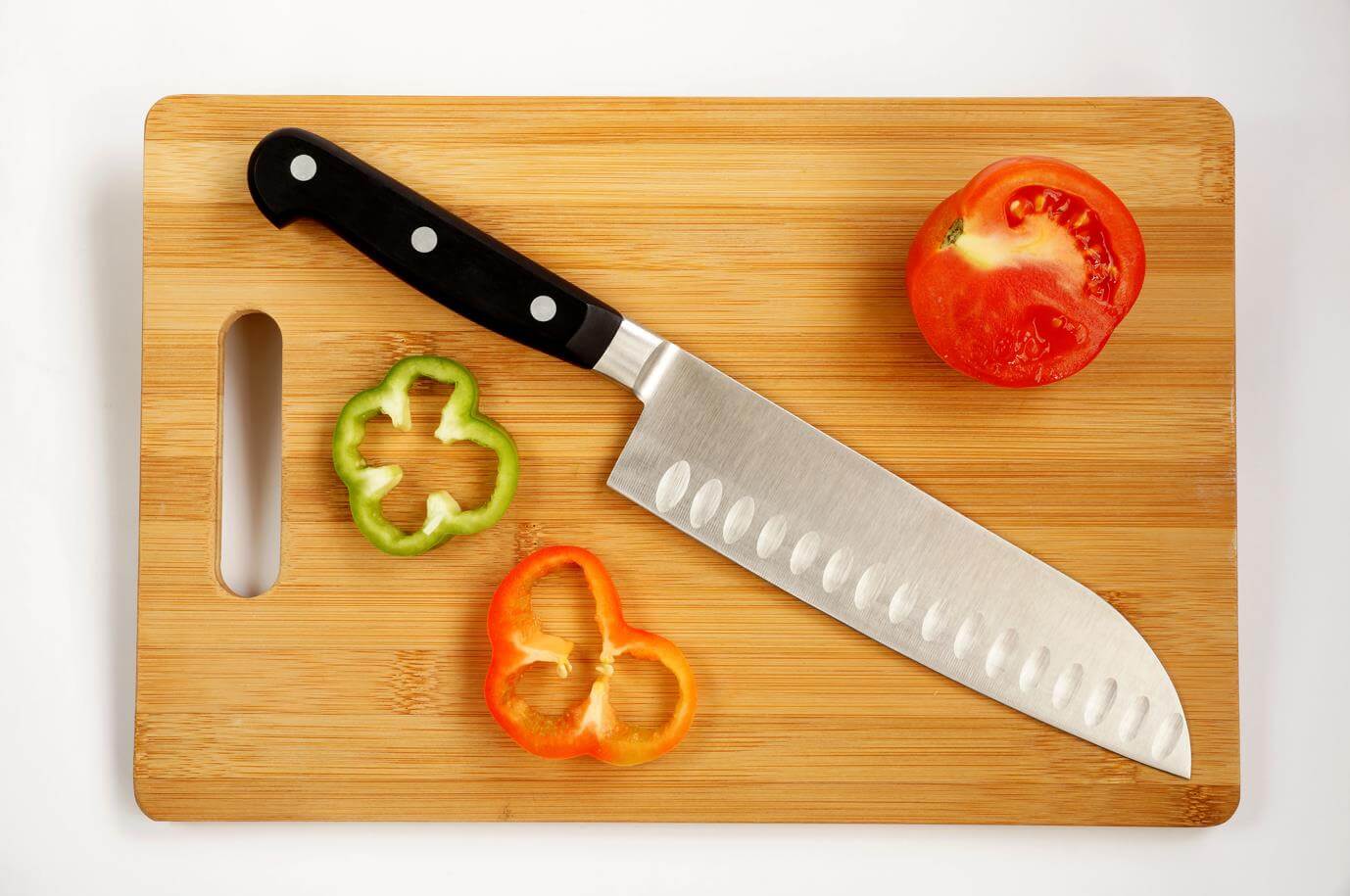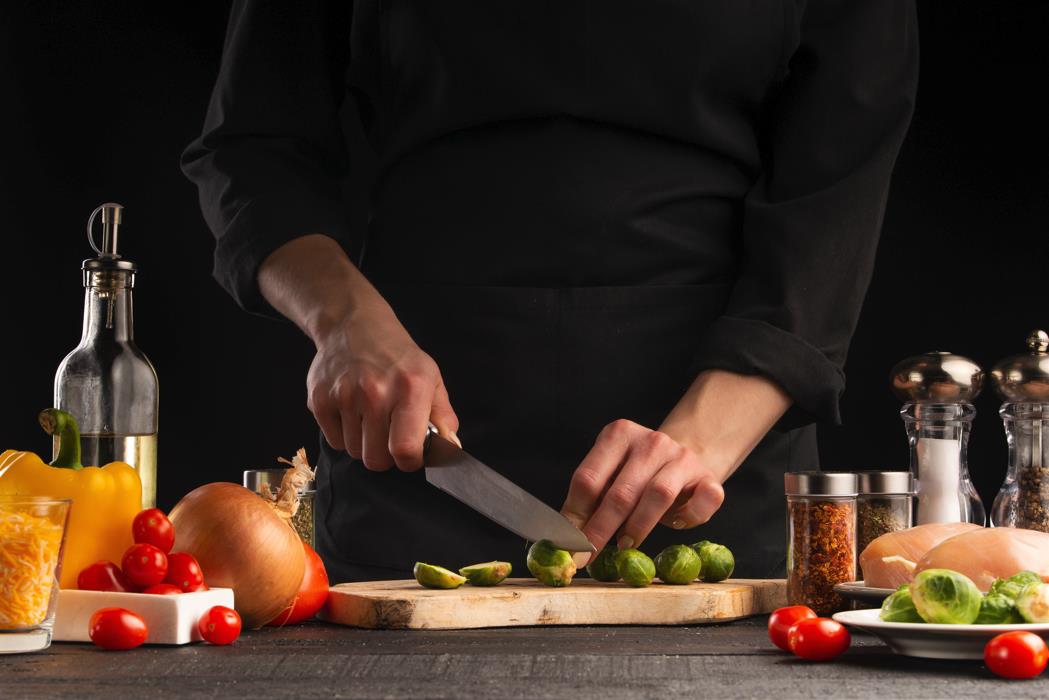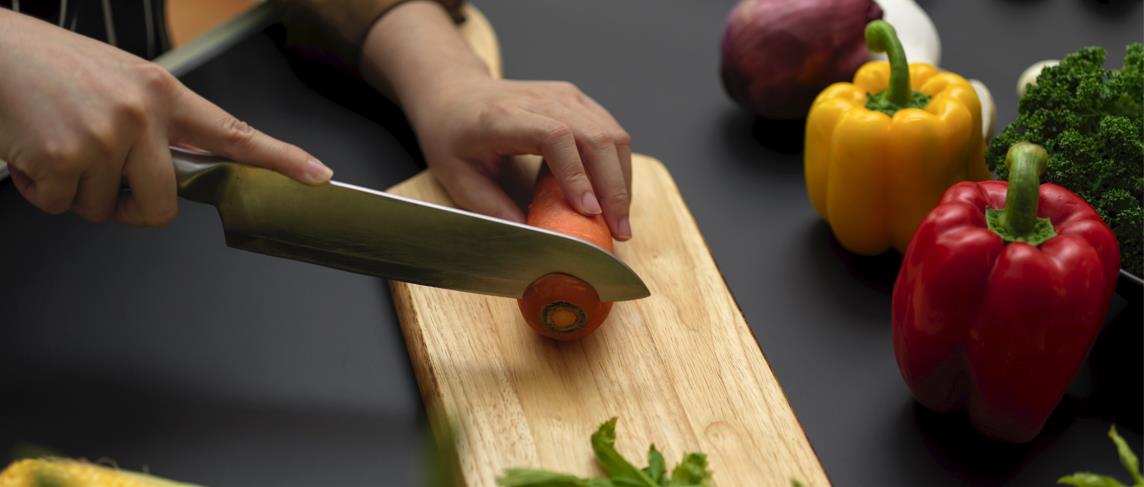The kiritsuke and santoku are two popular Japanese kitchen knives. There is a growing rivalry between Japanese styles and the standard western chef knife. You might be looking to buy your first kitchen knife, or you may just be curious about the differences. Either way, it is important to learn the features of all these knives.
- A kiritsuke is a long and thin knife that generally has a flat cutting edge plus a unique angular appearance. It combines features from traditional Japanese sushi and vegetable knives and is only used by skilled chefs.
- A santoku is the standard Japanese chef knife style that has become famous worldwide. Compared with most European designs, this has a relatively flat cutting edge and a round spine. Santoku knives can handle many ingredients, though can still be prone to chipping or cracking.
- A western-style chef knife is versatile and sturdy. The most common styles have a rounded cutting edge and a stainless steel blade. These knives can perform the roles of many specialized kitchen tools but may require regular maintenance in the long run.
That is a brief overview. In this article, we will highlight the similarities between the kiritsuke, santoku, and chef knife. Later on, we will look at the knives side-by-side to see how they perform in every crucial category.
Table of contents
How are the three knives similar?
All three knives can be classed as general-purpose chef knives. That means that they have more than one use and can be effective at cutting various ingredients with different techniques.
While not the traditional material for Japanese knives, the santoku and kiritsuke are available with stainless steel blades nowadays, just like western chef knives.
Traditionally, the santoku and kiritsuke had single bevel edges in contrast to the double bevel edge of a western chef knife. Today you can buy Japanese chef knives with double bevel edges too.
Now we know the (limited) similarities between the knives, let’s look at each variety more closely.
What is a kiritsuke knife?

A kiritsuke is a style of Japanese chef knife that is a lot less famous than the santoku and gyuto. From Japanese, its name translates approximately to “cut/slice open.”
Japanese-style knives are traditionally made with carbon steel. Their blades are designed to be very sharp and thin with a narrow edge angle. The carbon steel allows them to retain their edges for a long time, but increases the risk of corrosion and cracking in the blade.
Main features
The kiritsuke has quite a long and slim blade. Some models are curved, though most versions have very flat cutting edges. The spine is flat too and angles downwards from the handle. It also has an angled tip that sharply joins with the knife’s point.
Overall the blade of this knife has a very unique and angular appearance.
The kiritsuke can sometimes feature a western handle with a bolster, a full tang, plus scales with rivets. These knives more commonly have a traditional Japanese “wa” handle with a partial tang instead.
Uses
Some see the kiritsuke as a combination of two Japanese kitchen knives, namely the usuba and yanagiba models. The usuba is a vegetable knife while the yanagiba is a sushi knife. Both have single bevel edges ― a common feature in authentic Japanese knives that enables precise slicing.
The kiritsuke retains the single bevel, though can also feature a double bevel edge. Its blade does look like a mixture between the yanagiba and usuba, so can unsurprisingly handle vegetables and fish. This knife is particularly good at slicing thinly.
The kiritsuke can also handle fruit and herbs, though it is less suitable for cutting tough meats. The long and thin design is prone to snapping when cutting very tough ingredients. In fact, the awkward nature of this knife means it is only used by the most capable chefs in a Japanese kitchen.
Pros
- If you frequently prepare Japanese meals, the kiritsuke is a fantastic tool to have in your kitchen. Its design is particularly helpful for the delicate elements of Japanese cuisine. If you know how to use it, it will give you very thin and beautiful slices of fish and vegetables.
- The single bevel on this knife is extremely sharp and can make very clean cuts in most ingredients. If you prefer a symmetrical blade, you can buy a kiritsuke with a double bevel instead.
Cons
- Due to its dimensions, the kiritsuke is not easy to control, so home chefs may be frustrated when handling it. The difficulty of cutting with the kiritsuke means that only professional chefs can get the most out of this knife
- The kiritsuke has fewer applications than the santoku or western chef knife so is not used as regularly in professional or home kitchens.
What is a santoku knife?

The santoku is a Japanese chef knife that is much more familiar to international cooks. Actually, it is one of the most widely-used kitchen knives on the market. Its Japanese name translates to “three virtues” or “three uses.” This refers either to the different cutting motions or the various ingredients that this knife can cut.
Main features
Of the three knives in this article, the santoku usually has the shortest blade. Santoku knives tend to have a fairly straight cutting edge with a slight bend in the tip section. The knife’s spine starts straight and then curves very sharply down at the end of the blade.
A true Japanese santoku has a single bevel blade made from carbon steel, no bolster, a partial tang construction, plus a wooden “wa” handle. Now that the santoku style has spread around the world, more western versions can be found. For instance, they may have a double bevel stainless steel blade, a composite handle, a full tang, etc.
Another non-traditional feature that you will regularly see on a santoku is a Granton edge. This blade type has a row of dimples to prevent food from sticking without affecting the strength of the knife.
Uses
Compared to its Japanese counterpart, the santoku is more versatile and easier for beginners to use. Like the kiritsuke, the santoku’s mostly flat edge is perfect for vertical chopping motions.
The main foods that the santoku can prepare are meat, fish, and vegetables. It is also good for cutting noodles and fruit. Essentially, this is a great all-purpose knife for most ingredients you will encounter in Japanese cuisine. With that said, a good-quality santoku is perfect for pastries and cheese as well.
A santoku is not as robust as a western chef knife, which means you should not try to cut through bones or very tough meats with it.
Pros
- The smaller size of the santoku is excellent for chefs with smaller hands and anyone who prefers a more compact design.
- A santoku’s blade is sharp, thin, and (usually) very hard ― few knife blades will give you such a clinical chopping motion and precise cuts. The flat and sharp edge will land cleanly on your cutting surface.
Cons
- If your santoku has a single bevel edge, it takes more skill to accurately cut with its narrower blade. Furthermore, left- and right-handed cooks cannot share the same single bevel knife.
- A santoku is more fragile than a western chef knife. If made from carbon steel, it is less flexible too. The delicate blade with its somewhat brittle material means you should take care when cooking European cuisine, especially tough meats and vegetables.
What is a (western) chef knife?

Definition
When you think of a kitchen knife, you probably have the image above in mind. The western-style chef knife is one of the world’s most dominant designs.
The French and German knives normally have a full tang construction with rivets, scales, and a bolster. Their blades are often made with stainless steel and have a curved cutting edge with a mostly flat spine. The French chef knife is longer and slimmer than the German version.
Uses
No tool can replace as many specialized knives as the western kitchen knife. If you only have money to spend on a single knife, this is the one to pick.
A chef knife is a solid choice for standard chopping and slicing of meat and vegetables. This style can also work well as a carving, paring, bread, and filleting knife. While it cannot do any of those jobs perfectly, a European chef knife is something you can rely on for most cuisines.
Pros
- A western chef knife, often made with stainless steel, is easy to sharpen and does not rust easily. This material is also tough which means it can absorb impacts without chipping or cracking.
- Cooks who prefer a rock chopping motion will love the shape of this knife. The curved cutting edge rolls smoothly along cutting surfaces.
- The heavy spine and solid construction of this knife make it perfect for dealing with tougher ingredients as well as softer foods.
Cons
- Stainless steel chef knives have a tendency to wear out a little faster than carbon steel knives.
- Stainless steel is quite soft relative to some other metals. Therefore the surface of the knife can be scratched. While slicing through harder items, the blade may bend slightly. For a harder blade, opt for carbon steel or ceramics instead.
Head-to-head: kiritsuke vs santoku vs chef knife
| Kiritsuke | Santoku | Chef knife | |
| Price | Some cheaper options are available, but the best-quality models cost $200+. | The price of a santoku is similar to that of a standard chef knife.How much you pay generally depends on materials and build quality. | Plenty of great chef knives exist for under $100. |
| Approximate blade length | 9-12” | 5-8” | 6-10” |
| Blade design | Most of these knives have very flat blades.The spine is mostly very flat but has a very distinctive angled tip. | A mainly flat edge with a slight bend in the tip section.The spine starts flat then curves very sharply towards the knife’s point.Many santoku models have Granton edges. | A typical western chef knife has a curved cutting edge with a mostly flat spine and a pointed tip.German chef knives are wider than French versions.A Serbian chef knife has a more similar shape to a santoku. |
| Material | Traditionally this is made with carbon steel. Now you can find this knife with a stainless steel blade too. | Carbon steel originally.Because of its popularity, companies have started selling ceramic and stainless steel santoku knives as well. | Stainless steel is the standard material of French and German chef knives.Carbon steel and ceramics are increasingly common blade materials. |
| Applications | Primarily fish and vegetables.The slim and brittle blade may crack if used to cut bones or hard meats. | According to its name, the santoku can prepare meat, fish, and vegetables.It can deal with bread and fruits too. | A western chef knife can handle most ingredients and cuisines.It can perform many tasks but cannot replace specialized knives perfectly. |
| Technique | The long and slim kiritsuke blade is not easy to handle.The kiritsuke can make precise cuts both horizontally and vertically. | The mostly flat santoku edge is great for making clean, vertical cuts. | The round edge of a western chef knife lends itself to a rock chopping motion. |
Which one should you choose?

Price is not a huge factor when deciding which of these knives to buy. You can find all three styles at a range of prices from $50 to $500 and beyond. Most of the time, quality and price are linked. However, you might be surprised at how many decent knives there are for under $100.
You must consider the feel and shape of the knives too. If you prefer a bulkier, sturdier knife with a rock chopping motion, then the western knife is the obvious choice. If you want a thinner and more compact knife that offers smoother vertical chopping, opt for a santoku or kiritsuke.
When choosing a style, try to predict the types of dishes you plan to make in the future. Even if you wish to make Japanese meals, a western chef knife is enough for most of your needs. If you are very fond of Japanese cuisine, the smartest option is to master the basics of the cuisine with a santoku first. Only after a few years of practice should you consider buying a kiritsuke.
In conclusion, if do not yet have a kitchen knife, a first sensible purchase would be either a western chef knife or a santoku. Both are available with numerous blade and handle materials.
When deciding between these two knives, the one for you depends on your cooking style and preferred cuisine. However, in our opinion, the western style is slightly superior to the santoku thanks to its robustness and versatility.
Find a trusted knife seller
Now that you’ve chosen your style and material, it’s time to find a respected manufacturer of good quality blades. Cooks who prefer European chef knives will definitely love HDMD’s selection of handmade high carbon kitchen knives.









